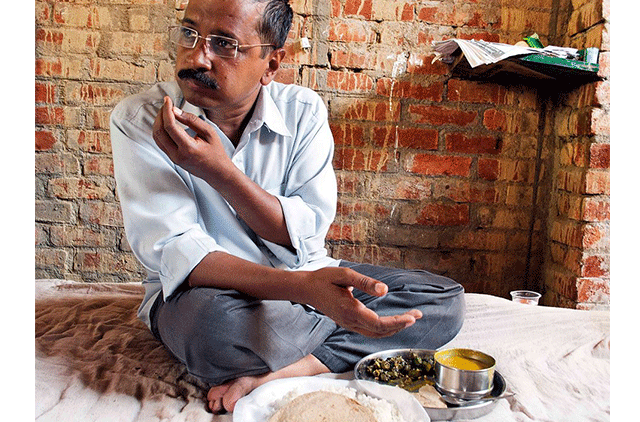
Just after the exit polls indicated a handsome victory for Arvind Kejriwal on the evening of February 7, a meme showed up on social networks depicting a hunter swinging a double-barrel gun in his right hand and a lame puppy in the left. The hunter was Aam Aadmi Party (AAP) chief Kejriwal and his prey Indian Prime Minister Narendra Modi.
The photo-shopped image conveyed a strong message: An all-powerful leader who once boasted about his “56-inch” chest hunted down by a short, cocky man dismissed by cynics as an anarchist suffering from persistent cough and an itch to take on India’s rich and mighty.
Barely 45 minutes after the counting of votes began Tuesday morning, it was abundantly clear that Kejriwal was heading for an unprecedented landslide victory. By lunch time, AAP had bagged 67 seats in the 70-member Delhi assembly where 67 per cent or nine million of 12 million voters exercised their franchise, beating all records. Clearly, this verdict has breached all geographical, social and economic barriers and is an overwhelming rejection of identity politics — a theme that has dominated Indian politics in recent years.
Just nine months ago, the Bharatiya Janata Party (BJP) had delivered a 100 per cent result, bagging all seven parliamentary seats in this city-state.
So, how has this tectonic shift happened? How did Kejriwal become a giant slayer? A bigger question would be how a bunch of political rookies who, to an outsider, may appear to be India’s version of Occupy Wall Street activists, humbled a behemoth that swept the political landscape just nine months ago?
Or how an outfit that did not exist two years ago managed to beat India’s two biggest parties — BJP and Congress?
In a personality-driven contest, it is tempting to crown the leader of the winning party and to an extent Kejriwal deserves credit for this impressive win. He is the face of the party and was slapped and mocked by rivals and a hostile media.
In December, the media attacked him for travelling to Dubai in business class, mocking his commitment to India’s poor. In an interview then, Kejriwal had told Gulf News that “a section of Indian media wanted to finish AAP”.
Just three weeks ago, Modi said Kejriwal was an anarchist and he should join Naxalites, Leftist rebels who are fighting Indian security forces in the jungles of several states. But to his sympathisers, Kejriwal is a hands-on politician who provided decisive, agenda-drive leadership to his team of former journalists, technocrats, lawyers and activists. However, it would be naive to attribute this victory only to the charisma of one man or to the cohesiveness of his team. That would be a simplistic reading of the events that have dominated political discourse in recent years.
Political discourse
The stunning result in Delhi is the victory of an idea. An idea that can potentially rewrite established rules of the game, an idea that may ultimately alter the political discourse in this nation of 1.25 billion people. This election has shown people of India are capable of rising above religious, caste and geographical identities to vote for a credible alternative. AAP has shown it makes good political sense to be honest, to raise election funds in a transparent manner, to remain identity and class neutral, to remain focused on constructive issues that affect the lives of people and yet managed to win handsomely, something its rivals will hopefully learn now.
Secondly, this verdict is a categorical rejection of Modi’s neo-liberal, pro-corporate agenda of governance and delivery. Since his election in May last year, Modi remained focused on boosting business sentiment by cutting red tape, by diluting laws, by introducing budget cuts, often at the expense of the interests of the common man. Modi’s approach of top-down development has largely benefitted corporates and stock markets. In contrast, Kejriwal’s campaign focused on day-to-day issues that impact people, both in urban and rural settings. He is a strong votary of the Centre-Left school of thought, believing in bottom-to-top style of governance.
Yet, getting a buy-in from voters, a significant number of who are semi-literate and have little understanding of governance, is a monumental task. Kejriwal and his team achieved this by involving people in shaping a vision document. The party reached out to people by holding neighbourhood meetings cleverly dubbed ‘Delhi Dialogue’, a feedback gathering process that eventually became the rule book for AAP cadres. Another team of engineers created a strong algorithm that mapped sentiments of India’s 300 million Facebook users. A faction-ridden BJP on the other hand failed to draw up an election manifesto and came up with a vague charter of promises.
Full of roadblocks
While the jury is out on whether this result has dented Modi’s popularity outside Delhi, Tuesday’s spectacular victory has put enormous responsibility on Kejriwal’s shoulders. He must now deliver on promises — cheap electricity and water, new schools and colleges, more hospital beds, transparency in decision-making, among others.
Transition of a grassroots movement from roadside protests to a party in power can be treacherous and full of roadblocks. Kejriwal’s first challenge will be to find experienced hands to run ministries, his party has few with experience in legislature and governance. Also, he must now open a line of communication with Modi and his Finance Minister Arun Jaitley who controls federal funding for states.
Kejriwal pleaded with voters to give him five years. Now that his wish has been granted, his government’s tenure may turn out to be the toughest five years of his life. Kejriwal, a former tax inspector, must now brace for intense media scrutiny and learn to deal with a hostile federal government.
Bobby Naqvi is the Editor of XPRESS, a sister paper of Gulf News.









